Welcome back to the In-App Purchase Inspector- our regular look at free-to-play games from the consumer's perspective.
In each instalment, we consider the incentives or pressure applied to make in-app purchases, their perceived value, the expansion offered by IAPs and the overall value of the experience.
The end goal is to see whether the game makes a good enough case for us to part with our cash, or whether players are content - or engaged enough - to 'freeload'
This time, we're taking a look at Star Wars: Galaxy of Heroes, the latest card battler from EA's mobile-focused Capital Games studio.
(Holo)tabletop gaming
While Kabam's Star Wars: Uprising took a relatively lore-heavy approach to the iconic licence, positioning itself shortly after the events of Return of the Jedi and featuring reams of referential dialogue, Galaxy of Heroes shoots for more universal appeal.
When you first start the game, it's immediately established that the in-game battles take place only in simulated, projected form on a Holotable - a game within a game, a virtual world within a virtual world.
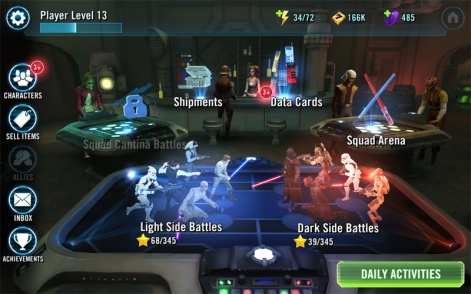
Conceptually confusing, perhaps, but a smart way of having series characters - and those from spin-offs such as The Clone Wars - come together and battle one another in a non-canonical realm.
Furthermore, this means that those less familiar with the series will have no trouble diving in, which is a relief for me in particular.
Here, Star Wars is little more than an overlay; the game itself leads. Thankfully, it's up to the task.
All about the stats
Galaxy of Heroes is a game that has enough confidence in its robust card-collecting and upgrading meta-game that it doesn't focus massively on the strategy of actual battles.
Indeed, taking cues from Asian free-to-play design (Dota Legends anyone?), it allows the player to automate and even simulate turn-based combat to get at those all-important rewards as fast as possible.
You can choose to play for yourself, picking out specific targets and attack types. However, the influence of strategy - or indeed luck - is minimal. For the most part, it's a pure numbers game.
When beaten, you're prompted to return to your upgrade screen to level up. There are no David and Goliath-style underdog victories here, and pure strength - or a good squad - invariably comes out on top.
At least to Western sensibilities, where we receive these kinds of experiences less often, it is initially jarring.
When you get into the rhythm of deploying upgrades and watching battles unfold, it all clicks into place.
However, when you get into the rhythm of deploying upgrades and watching battles unfold, it all clicks into place.
Traditional gameplay - the likes of combat, strategy, etc. - struggles to remain compelling over the long haul, which partly explains why games such as Mobile Strike lean so heavily towards menu-driven systems.
The idea is that the average player will tire of even the best mechanics after a relatively short period, whereas it's the far stickier meta-game - levelling up characters and unlocking new ones - that really retains players for the duration.
Sticking around
Retention is evidently a key concern for Capital Games, as it takes a softly-softly approach to monetisation - particularly in the early stages.
The main currencies are Credits (soft) and Crystals (hard), both of which are given out generously to start you off and throughout the game as mission rewards.
Simply, the former is used for upgrading existing squad members, while the latter is used to purchase data cards which spawn random new characters from across the Star Wars universe.
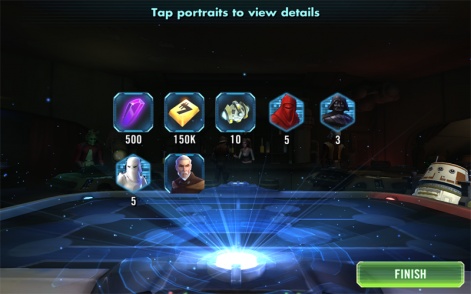
You're given 300 Crystals to start off with, worth approximately $2.50 in real money and just 50 Crystals shy of a Chromium Data Card - which drops a 1-4 star character.
Retention is evidently a key concern.
Crystal bundles range from 220 for $1.99 to 15,710 for $99.99, although I made it to level 14 without even being curious or pressured enough to look - a testament to the game's generosity.
There's also a rather attractive 'Daily Crystals Booster' option - similar to the 'Monthly Jewel' bundle we praised when discussing COLOPL Rune Story - which grants the player 300 Crystals up-front, plus a further 125 for every day they log in, for only $4.99.
Not only does this provide excellent value for the player, but it relates to Capital's aforementioned focus on retention. What it gets in return is not just money, but a 7-day commitment to keep coming back.
There's a big focus on daily login rewards, too, where you can claim an increasing number of Crystals every 5 days, plus big rewards for completing your list of pre-set Daily Activities.
Treading carefully
It's also interesting to note that Galaxy of Heroes pushes its request to enable notifications deeper into the game than most other titles, while making the process feel more reciprocal by offering a 100 Crystal incentive.
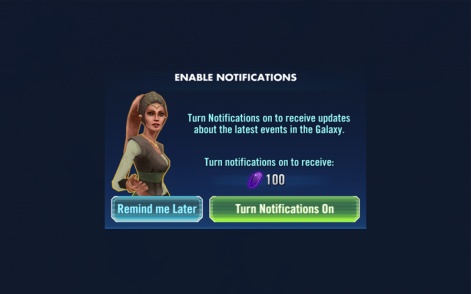
It takes the same approach when it comes to bundles and discounts, too.
The polar opposite of Mobile Strike, which is happy to slap you in the face with an IAP bundle offer as soon as you start playing, Galaxy of Heroes doesn't present its first starter bundle until around level 11.
Named the Dark Side Starter Pack, it dovetails perfectly with the dark side battles that are unlocked at level 12. I bought it, and for $4.99 I received:
- 3-Star Count Dooku character
- 500 Crystals
- 3 Darth Vader shards
- 5 Snow Trooper shards
- 150,000 Credits
- 10 5-star XP materials
This is more than enough to kickstart your dark side squad, and level up its members to the extent that you can power through the first set of battles - all for the same price as 610 Crystals.
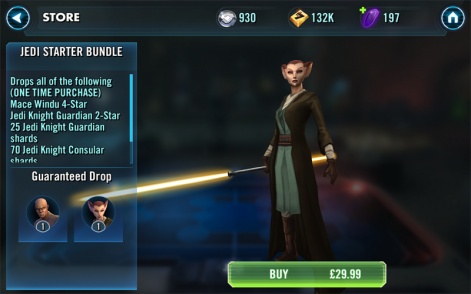
There are higher value bundles, too - for example the Jedi Starter Bundle, priced at $39.99 and introduced at level 16 - but they're smartly kept under wraps until you've proven yourself to be at least slightly committed.
It neither assumes nor demands that of you from the outset, and for that it deserves praise.
Plenty of energy
There's more, too. Boasting two energy systems, the F2P mechanic that ordinarily fills me with dread, it manages to keep the levels plentiful enough - and the costs cheap enough - that I haven't actually run out in standard play.
In fact, the only area of the game which is heavily energy-gated is the Squad Arena, Galaxy of Heroes' PvP component.
Here, you're given the choice of either waiting approximately 9 minutes or paying 50 Crystals between bouts.
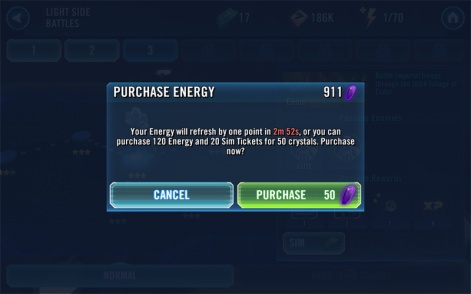
Elsewhere, the Bronzium Data Card - a free alternative to the Chromium Data Card, giving you the chance to spawn up to 2-star characters, materials, and credits - is a great option for non-spenders.
There is a 20 minute wait timer before you can claim your spoils, but alternatively you can use 250 Ally Points - a currency in plentiful supply and serving no other purpose - to claim immediately.
To conclude, Galaxy of Heroes has an approach to monetisation that sits well with me: getting players invested before encouraging spending, establishing reciprocity, and prioritising retention ahead of quick bucks.
It rather neatly wraps up a great year for Star Wars mobile games.






















